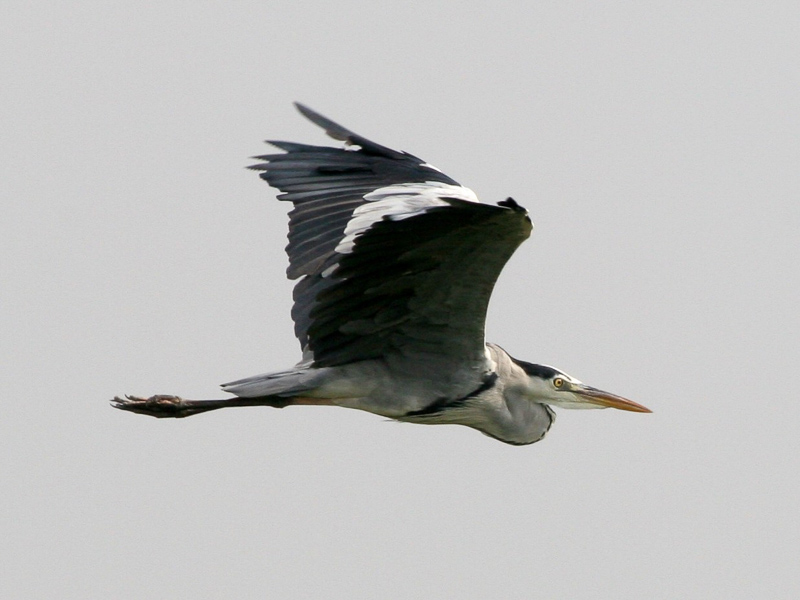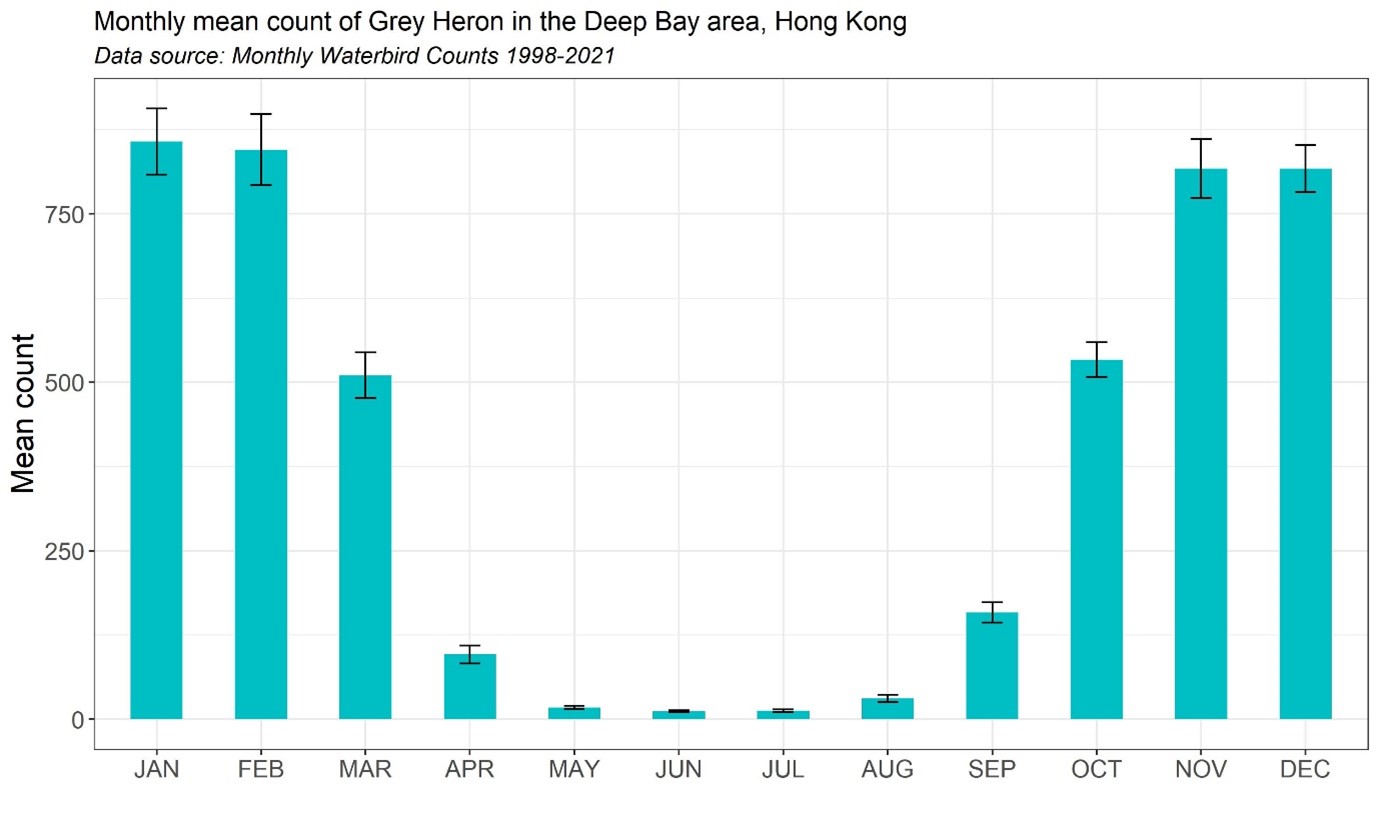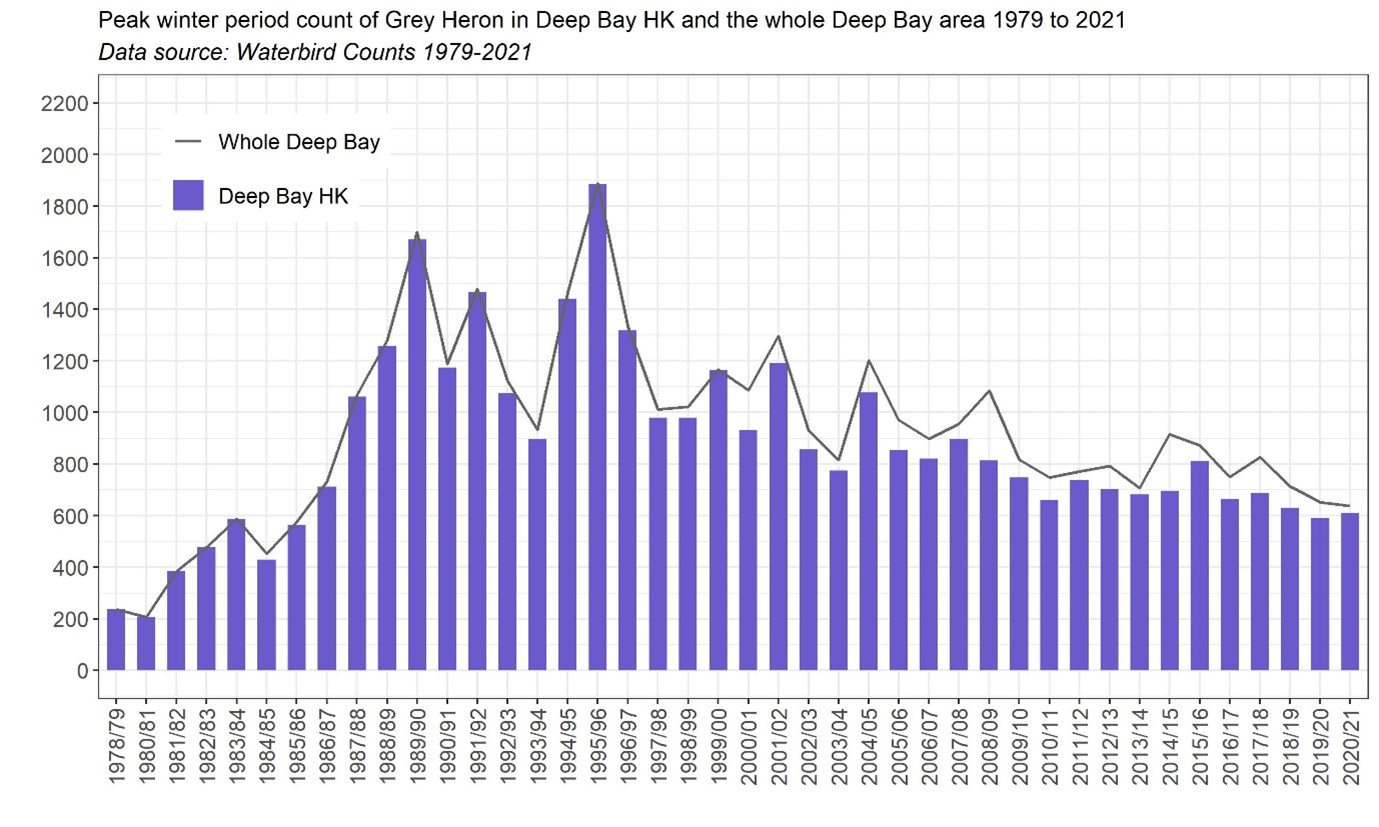Grey Heron Ardea cinerea 蒼鷺
Category I. Abundant winter visitor; scarce in summer. Has bred. Frequents wetlands throughout HK but concentrated in Deep Bay area.
IDENTIFICATION

Dec. 2005, John and Jemi Holmes. Adult.
90-98 cm. Large, with strong, fairly deeply based bill; greyish above and on neck, with white forehead, black sides to crown and short black nape plumes; whitish below with black streaks on chest and black thighs. Immatures are notably duller and more uniform. Bill and legs of adults yellowish, duller in immatures.

Dec. 2006, Matthew Kwan. Adult.
In flight holds neck folded and wings quite high and bowed; strong contrast between pale grey wing coverts and dark grey flight feathers, and a white triangle on the leading edge near the bend of the wing.
VOCALISATIONS
Away from the breeding site calls are loud and harsh. The typical relaxed flight call when flying to and from roosting and foraging areas or on nocturnal migration is a harsh ‘kyaaar’.
When flushed tends to call multiple times with either the first or one of the final notes loudest.
DISTRIBUTION & HABITAT PREFERENCE
Grey Herons occur mainly in Deep Bay where they feed in both intertidal, freshwater and brackish fish pond or gei wai areas. Elsewhere, they have been recorded throughout HK at coastal and inland wetland areas, though in much smaller numbers.
OCCURRENCE
The winter population is rather stable from November to February (Figure 1). Northward departure has begun by mid-March and continues through April into May. Numbers in June and July are similar and very low, while the first returning migrants are seen in August. A large arrival appears to occur before mid-October.
Figure 2 illustrates peak winter waterbird counts since 1978/79 and indicates that numbers increased from 200 to approximately 500 by the mid-1980s. Numbers increased further to an initial peak of 1,700 birds in winter 1989/90 and a higher peak of 1,885 on 10 February 1996 (two additional birds present at Fu Tian), the highest count on record in HK. While it is likely that some part of this increase was due to better access to Deep Bay, much would appear to be real. After the mid-1990s peak counts slowly and steadily declined to approximately 600 in winter 2020/21.
Based on winter waterbird counts in Deep Bay Sung et al. (2021) concluded that the wintering population declined from 1998 to 2017. The reason for this decline is unknown. Habitat changes arising from the sedimentation of Deep Bay since the training of the Shenzhen River or intensification of fish pond practices may have contributed, while the impact of climate warming may also be a factor if it has allowed more birds to spend the winter further north than any increase arising from birds that previously wintered to the south.
From 1958 to 1973 up to four birds were usually recorded in early and late summer. From 1974 onwards, however, the number of summer records increased until 1994 when Grey Herons were present all year. Higher numbers have been recorded in summer since then, with the highest count in June and July being 41 in 2005; this may simply be due to observer effort, however.
Migrating birds have been noted in spring from 24 February to 9 May and from 25 September to 6 November. Such birds are recorded in much higher numbers in spring, often as they soar above Mai Po NR before departing in the hour before sunset; the highest such count is 99 on 16 March 2012. At Pak Sha O, Sai Kung birds have been recorded on nocturnal migration from 24 September to 13 November.
Swinhoe (1861) described Grey Heron as ‘frequently seen’, Kershaw (1904) stated it was a winter visitor in ‘large flocks’, and Vaughan and Jones (1913) noted that it was resident on the West River and described breeding inland in Guangdong. Dove and Goodhart (1955) recorded it from 5 September to 25 May, whereas Herklots (1953) stated that up to 20 were generally seen. Its status has probably changed little during the past 140 years, though it is possible that the breeding population is now lower.
BREEDING
In 1990, breeding was first recorded at the A Chau egretry in Starling Inlet (Young 1991), and occurred again in 1993, when five nests were counted. Two juveniles were seen at the nest on 26 April, but by 19 May the nest was deserted. However, no breeding attempts have been recorded at A Chau since 1994, and the reason for the abandonment is unknown. Details of the breeding status and history of Grey Herons in HK are contained in Young and Cha (1995). In addition, two juveniles seen at Mai Po NR in June 2020 were considered locally bred.
BEHAVIOUR, FORAGING & DIET
Largely a nocturnally foraging species, birds can be seen departing in small flocks late afternoon and early evening from roost areas such as Mai Po NR and returning in the morning. Prey items recorded are fish (including Tilapia Oreochromis niloticus and Grey Mullet Mugil cephalus) and Mangrove Water Snake Enhydris bennettii.
Migration appears to commence in the evening when flocks can be seen soaring before departure; nocturnal migrants have been recorded over Pak Sha O, Sai Kung. In addition, migratory flocks have also been recorded in the daytime, including one over Tung Lung Chau that included a Purple Heron.
RANGE & SYSTEMATICS
Breeds from western Europe and Scandinavia east through Russia, Kazakhstan and Mongolia to east and southeast Siberia and south to northeast and north China (Martínez-Vilalta et al. 2020). In China present all year southeast of a line from Yunnan to Beijing and a summer visitor to lowland non-desert areas to the north (Liu and Chen 2020).
Four subspecies are recognised, of which A. c. jouyi occurs from north China, Korea and Japan south to Sumatra and Java. Nominate cinerea occurs west of here to western Europe, while the remaining two subspecies occur in Africa.
CONSERVATION STATUS
IUCN: Least Concern. Population trend unknown.
Figure 1.

Figure 2.

Dove, R. S. and H. J. Goodhart (1955). Field observations from the Colony of Hong Kong. Ibis 97: 311-340.
Herklots, G. A. C. (1953). Hong Kong Birds. South China Morning Post, Hong Kong.
Kershaw. J. C. (1904). List of birds of the Quangtung Coast, China. Ibis 1904: 235-248.
Liu, Y. and Y. H. Chen (eds) (2020). The CNG Field Guide to the Birds of China (in Chinese). Hunan Science and Technology Publication House, Changsha.
Martínez-Vilalta, A., A. Motis, and G. M. Kirwan (2020). Gray Heron (Ardea cinerea), version 1.0. In Birds of the World (J. del Hoyo, A. Elliott, J. Sargatal, D. A. Christie, and E. de Juana, Editors). Cornell Lab of Ornithology, Ithaca, NY, USA. https://doi.org/10.2173/bow.graher1.01
Swinhoe, R. (1861). Notes on the ornithology of Hong Kong, Macao and Canton, made during the latter end of February, March, April and the beginning of May 1860. Ibis 1861: 23-57.
Sung, Y. H., C. C. Pang, T. C. H. Li, P. P. Y. Wong and Y. T. Yu (2021). Ecological Correlates of 20-Year Population Trends of Wintering Waterbirds in Deep Bay, South China. Frontiers in Ecology and Evolution. Published 20 April 2021 doi: 10.3389/fevo.2021.658084
Vaughan, R. E. and K. H. Jones (1913). The birds of Hong Kong, Macao and the West River or Si Kiang in South-East China, with special reference to their nidification and seasonal movements. Ibis 1913: 17-76, 163-201, 351-384.
Young, L. (1991). The first breeding record of Grey Heron in Hong Kong. Hong Kong Bird Report 1990: 191.
Young, L. and M. W. Cha (1995). The history and status of egretries in Hong Kong with notes on those in the Pearl River Delta, Guangdong, China. Hong Kong Bird Report 1994: 196-215.

